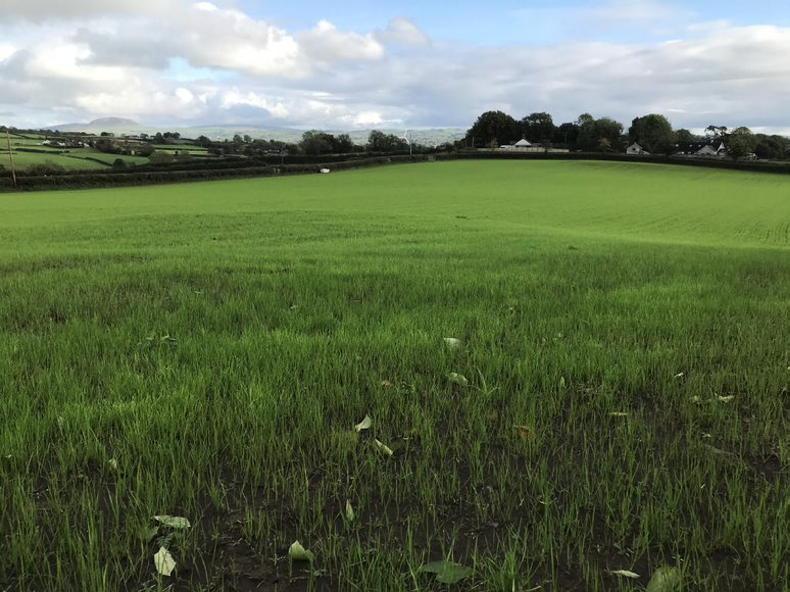A change in the weather saw James King house the milking herd on his farm outside Broughshane in Co Antrim on 18 October.There are currently 136 cows in the milking group, although a significant number of these are nearing the end of their lactation. The average yield across the herd stands at 26.2 litres.
A change in the weather saw James King house the milking herd on his farm outside Broughshane in Co Antrim on 18 October.
There are currently 136 cows in the milking group, although a significant number of these are nearing the end of their lactation. The average yield across the herd stands at 26.2 litres.
With James assuming maintenance plus 5 litres from forage, and feeding concentrate at 0.45kg per litre above this, cows are currently being offered an average of 9.5kg per head of a 18% crude protein nut in the parlour.
There are also 38 cows in a close-up group currently being fed round bales left over from 2020, along with a dry cow blend. A second group of 18 have recently been dried off, and will be the last animals to be housed.

An autumn reseed on the King farm.
Silage
Ahead of winter feeding, samples of first- and second-cut silage were sent for analysis to the lab at the Agri-Food and Biosciences Institute (AFBI) at Hillsborough in Co Down.
As shown in Table 1, the quality of both silages is generally excellent, with D-values of 72% and 69% (a D-value of 72% equates to a dry matter digestibility (DMD) of 77%).
The AFBI analysis includes an intake value which is effectively a measure of how much of the silage cows will potentially eat. The target is to have intake values of over 100. A key driver is dry matter (DM), and ideally, all silages should be above 25%.
The intake of a silage can also be negatively affected by a bad fermentation, with ammonia a useful indicator. It should be below 10.
In terms of the pH, both silages on the King farm are below 4, which again points to a stable fermentation.
Where pH falls under 3.6 it is quite acidic, and it may be necessary to add a buffer in the feed to keep intakes up, especially if the silage is quite wet.
If pH is above 4.2 it can indicate a poor fermentation has taken place, although a high pH is normal in a very dry silage as the lack of moisture limits the activity of lactic-acid-producing bacteria.
Feed face
While James has bales available from surplus grass, his main pit of silage contains first-, second- and third-cut grass silage, as well as wholecrop wheat.
With a large feed face, and different qualities of forage, it is vital that he maintains a well-managed pit face.
The starting point for that is to have a sharp blade on the shear grab to try to effectively seal the clamp each time silage is removed. It is a job James completed before opening the clamp.
All farmers must not underestimate the potential negative impact of in-silo losses. Once a pit is open, air can re-enter, allowing yeasts and moulds to develop which will feed on sugars and fermentation acids (such as lactic acid), greatly reducing feed value.
When yeasts and moulds are active, this increases pH, and the silage will start to heat, leading to further losses. Grass that was ensiled very dry (above 30% DM) will naturally be more prone to heating.
Research has shown that if it takes seven days to get across a pit face, up to 15% of the silage dry matter could be lost. This figure could be even higher in very dry silage, and if rainwater is hitting the feed face.
As well as operating with a sharp shear grab, take shallower blocks so that you are able to work across the face more quickly.
There is little point going to the effort of ensiling high-quality grass if subsequent management at feed out is poor.
Start made on
winter maintenance
With the milking herd now housed, it is an opportunity to get some maintenance work done to the grazing infrastructure.
James has had a digger in to scrape the top off some of the cow tracks, which will be resurfaced using blinding.
Decision to be made with autumn reseed
A 2ha autumn reseed has grown strongly throughout mild weather in October.
It is a mix of Moira, an intermediate diploid, and Fintona, an intermediate tetraploid variety.
While James had intended holding the reseed over to the spring before grazing, that plan may need revised.
“If he leaves it to the spring, there will probably be a dead matt of grass at the base which will limit growth. A light grazing by the sheep would help tiller the sward. Do it sooner rather than later, and have the sheep off by mid-December,” suggests CAFRE Dairylink adviser Kathryn George.





SHARING OPTIONS: